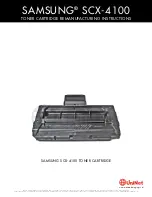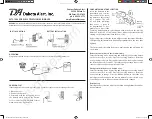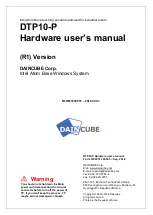
Page 2 of 4 / IOM 1175
5. Avoid locations close to windows, adjoining outside
walls, or doors that lead outside.
6. Avoid locations close to air registers or in the direct path
of air from them.
7. Make sure there are no pipes or duct work in that part of
the wall chosen for the sensor location.
8. Never locate sensor in a room that is normally warmer or
cooler than the other areas being conditioned.
9. Avoid locations with poor air circulation, such as behind
doors or in alcoves.
10. In the home, the living or dining room is normally a
good location, provided there is no cooking range or
refrigerator on opposite side of wall.
Outdoor Sensor
Select Sensor Location
Proper location insures that the remote sensor will provide a
correct outdoor temperature reading. Observe the following
general rules when selecting a location:
1. The interior mounting base can be located a maximum of
300 feet from the thermostat.
2. Install the interior mounting base within 12 ft. of the
intended outdoor probe location.
3. Never install the outdoor probe where it will be exposed
to direct light from lamps, sun, fireplaces or any
temperature radiating equipment.
4. Make sure there are no pipes or ductwork in the wall
chosen for the base location.
5. Outdoor temperature measurement requires installing the
probe outdoors. Good probe locations would be under a
bay window or overhang, out of direct sunlight. Direct
sun exposure will affect sensed temperature. Install probe
with spacer to obtain a more accurate temperature.
Figure 1: Outdoor probe mounting detail
Mounting
Surface
Spacer
6. Although connected to the probe wire for outdoor
temperature sensing, the interior mounting base must be
placed
indoors
. Therefore, the interior mounting base
must be installed near the perimeter of the building, so
that the probe wire can be run through to the outside of
the structure and placed in the selected (shaded) location.
The outdoor probe wire is 12 feet long (
and should
not be cut or spliced
), so plan the placement of both
the probe and interior mounting base accordingly. Any
excess wire may be coiled or bundled. The probe should
be connected to E2 as shown in
Figure 3
.
Safety
WARNING
Wiring connections must be made in accordance with all
applicable electrical codes. Failure to read and follow all instruc
-
tions carefully before installing or operating this control could
cause personal injury and/or property damage.
CAUTION
To prevent electrical shock, disconnect electric power to system
at main fuse or circuit breaker box until installation is complete.
NOTICE
If in doubt about whether your wiring is millivolt, line, or low volt
-
age, have it inspected by a qualified heating and air conditioning
contractor or electrician.
Do not exceed the specification ratings.
All wiring must conform to local and national electrical codes
and ordinances.
This control is a precision instrument, and should be handled
carefully. Rough handling or distorting components could cause
the control to malfunction.
The remote sensors cannot be used with systems where power
interruptions are part of normal system operation.
Specifications
Note:
Remote sensor 910129095 is approved for indoor use
only.
Temperature range:
40° to 99°F
Operating humidity range:
0 to 90% RH (non-condensing).
20-gauge, three-conductor shielded cable must be used for all
remote sensor wiring.
Note:
Remote sensor 910129096 is approved for outdoor
use only.
Temperature range of outdoor probe:
-40° to 140°F
20-gauge, three-conductor shielded cable must be used for all
remote sensor wiring.
Installation
Indoor Sensor
Select Sensor Location
Proper location insures that the remote sensor will provide a
comfortable home or building temperature. Observe the fol-
lowing general rules when selecting a location:
1. The remote sensor can be located a maximum of 300 feet
from the thermostat.
2.
Locate sensor about 5 ft. above the room floor level.
3. Install sensor on a partitioning wall, not on an outside wall.
4. Never expose sensor to direct light from lamps, sun,
fireplaces or any temperature radiating equipment.






















